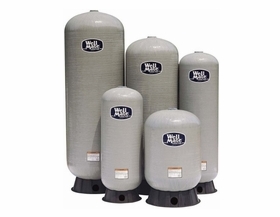Pressure Tanks

In a closed, automatic water system a pressure tank is used to store water and maintain system pressure between specified limits (such as 30 to 50 PSI). As the water level in the tank rises, tank air is compressed in the upper part of the tank until the upper pressure limit is reached (i.e., 50 PSI). At this "cut-out" point a pressure switch opens the electrical circuit to the motor and the pump stops. The compressed air in the tank acts like a spring pushing down on the water to create system pressure. When a valve is opened in the water system, the air pressure in the upper part of the tank forces water to flow out of the tank and into the system. As the water is drawn from the tank, the air occupies a larger space and the pressure drops until the lower limit is reached (i.e., 30 PSI), At this cut-in point the pressure switch closes the electrical circuit to the motor and the pump starts. A cycle is thereby completed. A bladder fiberglass bladder tank should be pre-charged 4 PSI less than the system presasure switch cut-in pressure. A metal bladder tank should be pre-charged 2 PSI less than the cut-in pressure.


